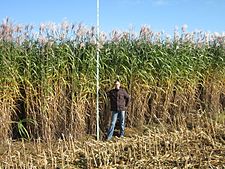Biomass, in the context of energy production, is matter from recently living (but now dead) organisms which is used for bioenergy production. Examples include wood, wood residues, energy crops, agricultural residues including straw, and organic waste from industry and households.[1] Wood and wood residues is the largest biomass energy source today. Wood can be used as a fuel directly or processed into pellet fuel or other forms of fuels. Other plants can also be used as fuel, for instance maize, switchgrass, miscanthus and bamboo.[2] The main waste feedstocks are wood waste, agricultural waste, municipal solid waste, and manufacturing waste. Upgrading raw biomass to higher grade fuels can be achieved by different methods, broadly classified as thermal, chemical, or biochemical.
The climate impact of bioenergy varies considerably depending on where biomass feedstocks come from and how they are grown.[3] For example, burning wood for energy releases carbon dioxide. Those emissions can be significantly offset if the trees that were harvested are replaced by new trees in a well-managed forest, as the new trees will remove carbon dioxide from the air as they grow.[4] However, the farming of biomass feedstocks can displace natural ecosystems, degrade soils and take land out of food production. It may also consume water for irrigation and fertilisers.[5][6]
- ^ "Biomass explained - U.S. Energy Information Administration (EIA)". www.eia.gov. Retrieved 2023-01-24.
- ^ Darby, Thomas. "What Is Biomass Renewable Energy". Real World Energy. Archived from the original on 2014-06-08. Retrieved 12 June 2014.
- ^ Correa, Diego F.; Beyer, Hawthorne L.; Fargione, Joseph E.; Hill, Jason D.; et al. (2019). "Towards the implementation of sustainable biofuel production systems". Renewable and Sustainable Energy Reviews. 107: 250–263. doi:10.1016/j.rser.2019.03.005. ISSN 1364-0321. S2CID 117472901. Archived from the original on 17 July 2021. Retrieved 7 February 2021.
- ^ Daley, Jason (24 April 2018). "The EPA Declared That Burning Wood Is Carbon Neutral. It's Actually a Lot More Complicated". Smithsonian Magazine. Archived from the original on 30 June 2021. Retrieved 2021-09-14.
- ^ Tester 2012, p. 512.
- ^ Smil 2017a, p. 162.
© MMXXIII Rich X Search. We shall prevail. All rights reserved. Rich X Search


